
Two of our grandsons came to visit and began asking questions about the paranormal. Grandpa wanted to tell them our story of our visit to Cathar Country in South of France.

Two of our grandsons came to visit and began asking questions about the paranormal. Grandpa wanted to tell them our story of our visit to Cathar Country in South of France.

Replica of the Reliquary of St Mary Magdalene
carried in procession
Valerie Barrow and her husband John spent the end of September, all of October and the early part of November 2010 travelling through the UK, France and parts of Egypt. What follows is Valerie’s record of their visit to the Saint-Maximin la Saint-Baume region, where Mary Magdalene resided after her flight from Egypt. There has been a constant monastic presence here preserving the tradition (and the relics) of Mary Magdalene since the Fourth Century.
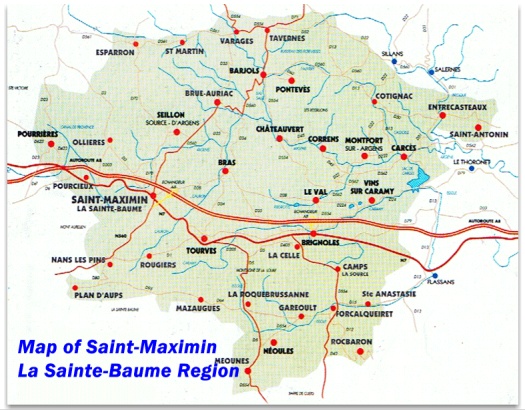
Map of Saint-Maximin la Saint-Baume Region. Click to see a larger map
The area is well known for a geological formation known as Massif, which will come into play in the story which is to unfold.
The region, as evidenced by some archaeological finds, was already a religious center some 3000 years ago. The existence of a huge reserve of water which is fed by all the rivers of the region explains that since prehistoric times, the pagan cults dedicated to the goddesses of fertility were developed there. Some historians believe that the forest has been frequented by the “Druids” at the time of the presence of Celts from the fourth century BCE.

Geological formation known as Massif at Sainte-Baume
The attractive market town of Saint-Maximin lies 300 metres above sea level, surrounded by vineyards and sheltered by the three great ranges of Mont Aurelien, Mont Sainte Victoire and the Massif Sainte Baume.
Originally a Gallo-Roman site north east of Marseilles and The Camargue, this ancient town owes much of its fame to that part of its rich history touched by the mystique and legend of Mary Magdalene.

Basilica of St Mary Magdalene surrounded by the Royal Convent
The relics of the saint were discovered here in 1280, in a crypt dating back to the fourth century AD, and thenceforth preserved in a primitive local church. Later, in order to accommodate the ever burgeoning influx of pilgrims, Charles II of Anjou, Count of Provence and nephew to Saint Louis of France ordered, with the blessing of Pope Boniface VIII – the construction of the Basilica of Saint Mary Magdalene and Convent on the same spot.

Original plan of the Basilica of St Mary Magdalene showing the location of the crypt.
The Basilica was never completed on account of the Black Death,
and so the entry of the Basilica shows the unfinished face

John Barrow standing in front of the Basilica of St Mary Magdalene; the unfinished front is visible
John and I are entranced with being able to stay in the Royal Convent, once occupied by Dominican monks but now converted to comfortable accommodation and restaurant.

View of the Dining Room of the Royal Convent at Saint-Maximin.
Note the white orb overlaying the bunch of roses, top right
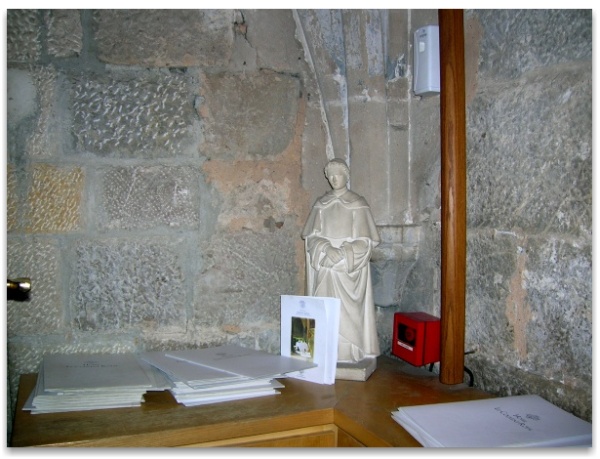
A Dominican monk overlooks the menu in the dining room of the Royal Convent
We soon begin the short walk, virtually next door, to explore the magnificent Basilica. I know the remains of Mary Magdalene are kept in the crypt and I am anxious to view them.

Entrance to the Basilica of St Mary Magdalene at Saint-Maximin
Just after we arrive, the crypt is closed because a sacred ceremony – a Confirmation of Children – is taking place. John and I decide to wait until the ceremony (which lasted about hour) was over.
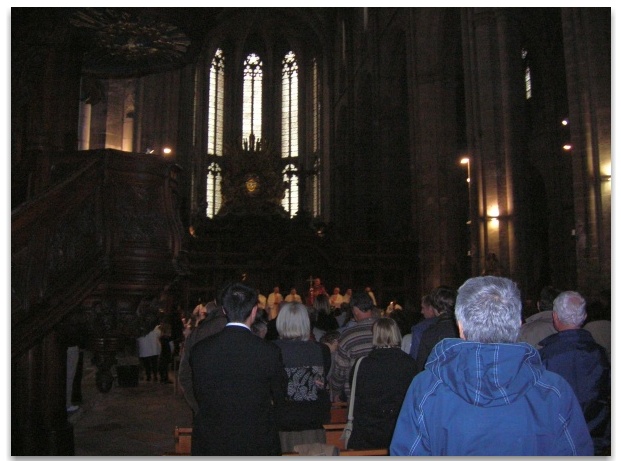
Confirmation Mass was taking place in the Basilica of St Mary Magdalene at Saint-Maximin

The High Altar in the Basilica of St Mary Magdalene at Saint-Maximin
While waiting for the Crypt to re-open after the Confirmation, I was led to the following photo in the Cathedral, Trilogie, which is believed to be the spirits of the Three Marys.

Trilogie, depicting the spirits of the Three Marys at the Basilica of St Mary Magdalene at Saint-Maximin
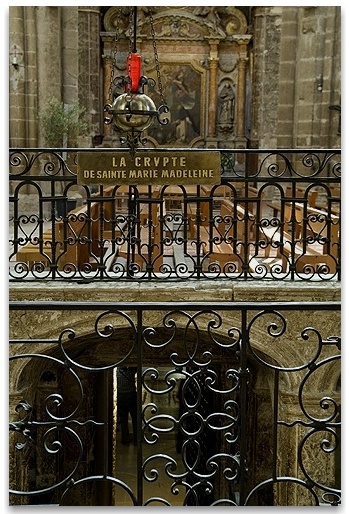
View of the Crypt at the Basilica of St Mary Magdalene at Saint-Maximin
When the Crypt is opened I ask if I can take a photo of the shrine of Mary Magdalene with the skull inside. (see Jehanne/Judith half sister of Issa – Jesus.) I ask my mentor if it is really she? He replies,
“It It is indeed, my dear, for all have come to recognise her and bless her for her work – the ones that understand and know from the origins from which she came.

Valerie’s photo of the Shrine in the Crypt
at the Basilica of St Mary Magdalene at Saint-Maximin
The photo that you have – IS – an extra light my dear, so do not question it. It is in acknowledgement of your presence and she is very pleased to see you. Understand her spirit is not just in the crypt, but is omnipresence – and it will follow you to the mountain cave. “
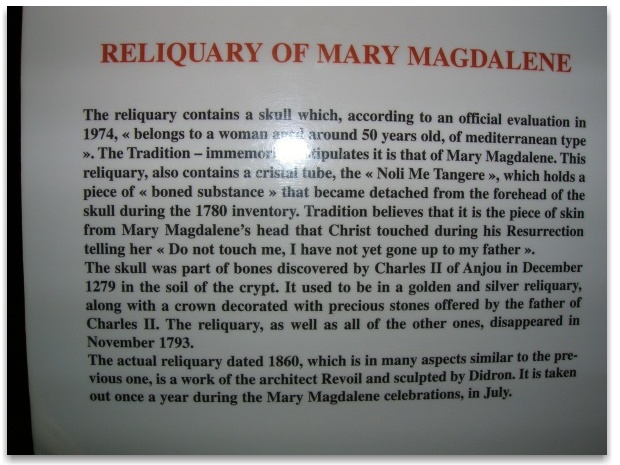
Notice at the Shrine in the Crypt
at the Basilica of St Mary Magdalene at Saint-Maximin

Altar in the Crypt
at the Basilica of St Mary Magdalene at Saint-Maximin

Shrine with Skull of Mary Magdalene
The Crypt also houses the sarcophagi of Saint Maximin, Saint Sidoine, Saint Marcelle and Saint Suzanne—companions of Saint Mary Magdalene on the boats.

Replica of the Reliquary of St Mary Magdalene
carried in procession;
The Feast Day of St Mary Magdalene is July 22nd
Where we witnessed the evocation of the Marys landing at the Camargue along with six other members of Jesus’s family, it was said Saint Maximin was also one of them. It would seem he moved on to the mountain area with Mary Magdalene to spread the teachings.

Cover of the Annales Ecclesiastici by Cardinal Caesar Baronius
There is another legend written by Cardinal Baronius, curator of the Vatican Library, in his “Annales Ecclesiastici” (ecclesiastical annals from Christ’s nativity to 1198), consisting of twelve folio volumes, is a history of the first 12 centuries of the Christian Church) giving a complete list of passengers who were said to travel to Marseilles to escape the danger that existed after Jesus was crucified: I am prompted by spirit to research the Web about Joseph of Arimathea and this is the website I am led to: Web Archive (archive of a web page that has since disappeared after creating this page)
“Joseph, with many disciples traveled from the holy land by Phoenician boat and landed at Marseilles (a Phoenician trading post), in the Vienoise province of the Gauls (France) in the year 35 AD. From there Joseph went on to England, to establish seminaries and send out missionaries. Cardinal Baronius, Curator of the Vatican library, in his “Ecclesiastical Annals“, gives this account. “In that year the party mentioned was exposed to the sea in a vessel without sails or oars. The vessel drifted finally to Marseilles and they were saved. From Marseilles, Joseph and his company passed into Britain and after preaching the Gospel there, died.”
Here is Cardinal Baronius’ complete list of passengers:
|
|
|
Other records state that James and Mary, the mother of Jesus, were also in the boat. Philip was waiting for the travelers in France. There is testimony asserting his commission in Gaul, all of which say that he was received and consecrated Josephus the Apostle to Britain, prior to his journey there.”
Alcheringa, (who often speaks on behalf of Cosmic Sai Baba) has advised that there were many ships that came with the refugees from Egypt. The Camargue is not far from Marseilles. The Camargue gypsies hold the legend as told about in my article “Les Saintes Maries de la Mer” that St Salome, St Jacobe and Sarah, along with St Maximin landed at the Carmargue and Alcheringa says, St. Mary Magdalene, Mother Mary and her 2 daughters also landed there along with Joseph of Arimathea and Jesus’ brother James. There were others not mentioned.
Those Saints who have sarcophagi nearby the reliquary of Mary Magdalene at the Basilica here at the village Saint Maximin, are St. Maximin, St. Sidonius, St. Salome, St. Suzanne, who are the same people who are mentioned in the previous list (with the exception of St. Suzanne)
2000 years later, the records of antiquity are difficult to decipher. A companion or disciple is often referred to by name, or from where they came from, or a son of – in different ways so that it is difficult to know when it is the same person being recorded in manuscripts written by different scribes.
There were many who left the Holy Lands via Egypt for safety reasons, after Jesus was crucified. Those, particularly the women, who traveled to and stayed in South of France (then known as Gaul) were still in danger and had to go about their mission of spreading the teachings quietly and almost secretly.
Joseph of Arimathea traveled with others to his familiar territory in the Britannic Isles and began his teaching there. He went on to establish the first Christian Church at Glastonbury. It was not so dangerous there, even though it was still part of the ancient Roman Empire.
In my next article I will be speaking about our visit to Glastonbury, U.K.
Returning to our visit to Saint Maximin, we later walked around the old town, noting how narrow many of the streets were.

Narrow byways of Saint-Maximin; not much room to pass the car!
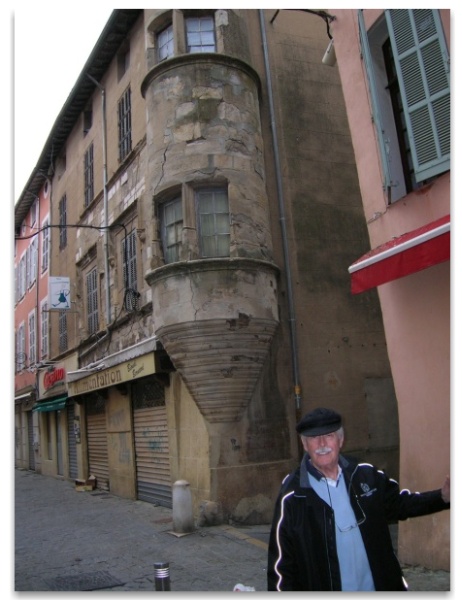
Narrow byways of Saint-Maximin; the room in the corner behind John looks like it is about to fall away.

Some of the lovely cakes we saw on our walk around Saint-Maximin
Go to PART TWO: Our visit to the grotto LA SAINTE-BAUME
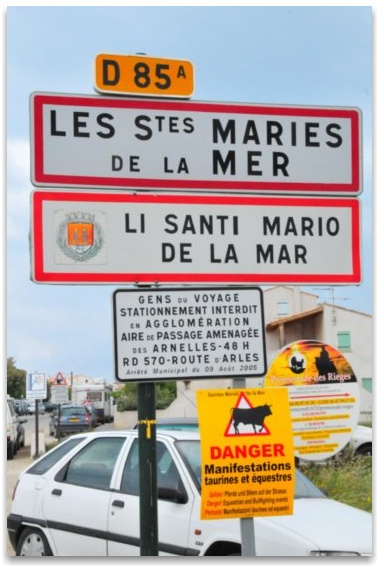
Roadsign at the entrance of the town of Les Saintes Maries de la Mer
Valerie Barrow and her husband John spent the end of September, all of October and the early part of November 2010 travelling through the UK, France and parts of Egypt. What follows is the narrative of the visit to the Bay of Mary’s, South of France and the sacred event that was to unfold, unbeknownst, for them.
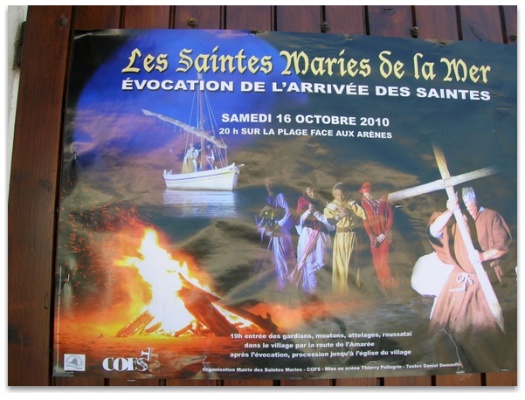
Enactment notice – Evocation of the arrival of Les Saintes Maries de la Mer
We were constantly guided while moving from one place to another when travelling – the only real thing I wanted to research before we left Australia upon our journey, was the Bay of Mary’s in South of France where it is said members of Jesus family escaped to after he was crucified.
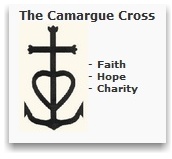
The Camargue Cross of Les Saintes Maries de la Mer
One Thursday afternoon we are driving into the small village on the Bay of Mary’s and the sign in the photo above is seen everywhere in the village. We had no idea that there was to be a re-enactment of the landing of the Marys on the forthcoming Saturday night. This re-enactment only happens once a year in October and now we find we have arrived in time to witness it. Thank you Holy Spirit!

Idol of St Sarah, (also known as the black Kali, servant girl to the Marys and Patron Saint of Gypsies
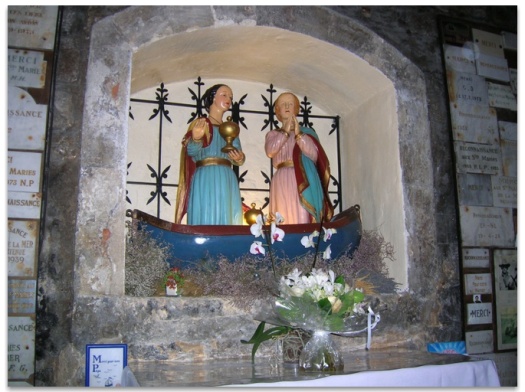
On the left, Mary Salome holds an alabastar jar (often associated with Mary Magdalene) with Mary Jacobe (also known as Mary, Mother of James (in Latin, Jacobe) standing in a boat
A day of rest was welcome, giving time also to explore and get to know this place.
We found the Saintes-Maries-de-la-Mer Church where the effigys of Mary Salome and Mary Jacobe along with Sarah are carried down to the sea at their annual sacred Festival held in Spring. These Marys are all said to be the family of Jesus. But that Festival is not the evocation that we are to see on Saturday night. To read more about that Festival, see here

The medieval fortress church of Saintes-Maries-de-la-Mer
The people of the Camargue wetlands are gypsies with a strong Spanish influence, who have held the legend of the landing of The Marys for nearly two thousand years. “Gypsies” is a term used for Egyptians who fled the temples, many of them originally gifted priests and priestesses, when they were invaded long before 1 BC. (Other legends tell they were expelled from Egypt for harbouring the Infant Jesus.) They knew the ‘family’ and wanted to protect them. So they knew of the Essene they called Issa and they also knew of him being crucified. Their secrets were held in their Tarot cards.
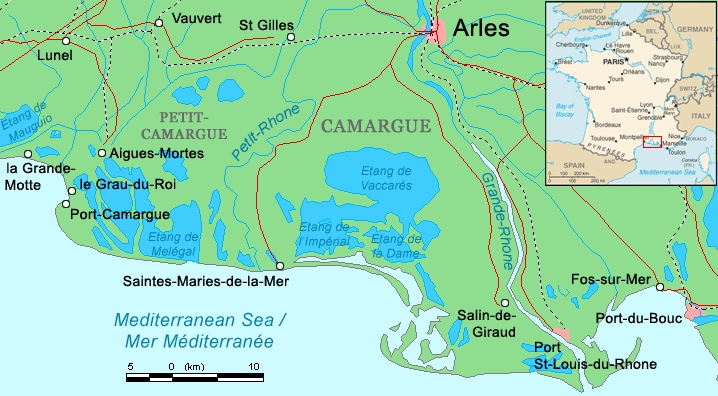
Map of the Camargue Region of South France
The Camargue region is the Delta of the river Rhone, made up of lakes and marshlands, giving home to over 400 species of wild birds. It is known as the cowboy country of France where white horses and black bulls run wild. When the horses are born they are black or dark brown and as they age they gradually become white. The Gypsies are herdsmen and superb horsemen. A long stick with a three pointed end is used to poke the bulls into a certain direction. Sheep, goats, bulls are all herded onto the ‘stage’ area to demonstrate their skills before the actual enactment is performed. We are told the bulls are not the same as Spanish bulls with large horns that point downwards, but rather the Camargue bulls’ horns point up to heaven. When they have bullfights, the bull is not killed but rather festooned with flowers after the bull has been made submissive.
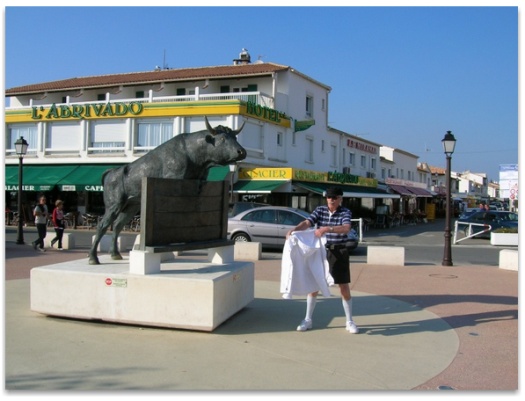
John making the bull submissive with a white parley cloth
John and I sat in a prime position on the beach, to watch “The Evocation“. Eager crowds gradually gathered around the fenced area of where the enactment was to take place.

Riders on white horses prepare for the evocation of Les Saintes Maries de la Mer

Oxen drawing a wagon across the sands in preparation for the evocation of Les Saintes Maries de la Mer

The sun sets on the crowds gathered for the evocation of Les Saintes Maries de la Mer
Complicated stage lights had been erected near us with some adjustments taking place. Romantic music was played to entertain the waiting people – there was not a religious feeling to the set, but rather a stage play of a legend. Finally sheep were herded onto the sandy stage leading to the water. The fine horsemen came galloping in, and later goats and the white horses and black bulls came. All were paraded by the Gypsies and herded off the stage leaving the time at 8pm when the event – the Evocation proper began. A little boat out to sea on the waves, was spotlighted and slowly made its way to shore.
Nine bonfires were lit to welcome them and to show the way to where the gypsies were.
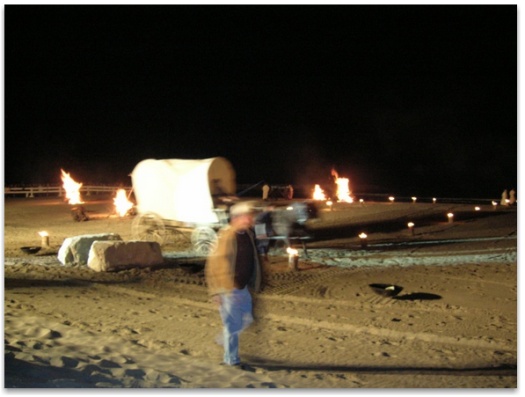
Nine bonfires were lit for the evocation of Les Saintes Maries de la Mer; the caravan crossing to position
The gypsies dressed, as they would have been 2,000 years ago, crowded to the waters edge and assisted the refugees ashore. Although the area was part of the Ancient Roman Empire, this watery region remained safe and separate at that time.
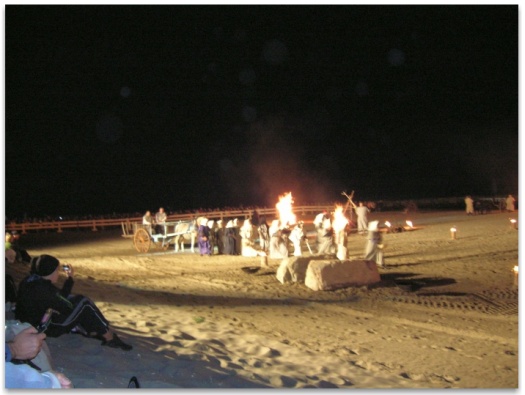
Small orbs linger above the dray and the actors the evocation of Les Saintes Maries de la Mer
Both John and I were overwhelmingly flooded with emotion as tears ran down our cheeks. Words were being spoken over the loud speaker relating the story in French; I mentally chastised myself for not bringing a recorder to be able to translate it later.
Not understanding what was being said – put us in an observation mode, leaving us free to receive insight and understanding from within our own soul memories, for both John and myself could remember being part of that ancient time.

A large blue orb lingers above the evocation of Les Saintes Maries de la Mer
I strongly felt a starship was watching over the whole event. Then energy created was palpable and peacefully beautiful. I asked ‘upstairs‘ to show themselves as I took photos in the dark. Movement is in the photos but Light from the ether shows through. The first one you can see is a major Blue Orb which I am advised from my mentor is like a strobe light used by scientists when observing happenings in deep water. So too, from the Star Peoples’ point of view, they use a similar strobe light to observe what is taking place in the heavier atmosphere of our earth plane. It also serves to up-lift the energy of the event taking place.
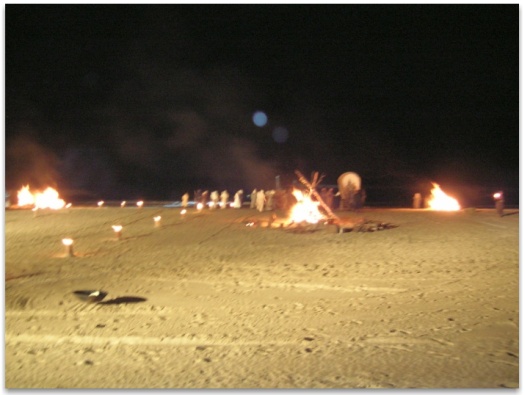
Two blue orbs linger above the wagon at the evocation of Les Saintes Maries de la Mer
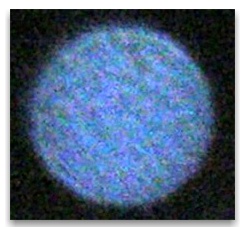
Enlargement of the blue orb above
the evocation of Les Saintes Maries de la Mer
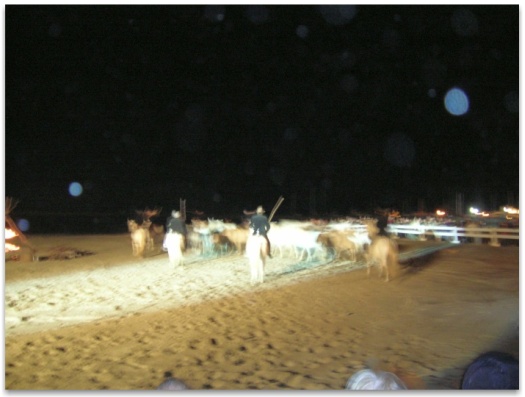
Three blue orbs (along with many other orbs) linger nearby the cattle being corralled at the evocation of Les Saintes Maries de la Mer
When all the sea-faring family had arrived, they were greeted and brought up closer to the awaiting crowds, viewing the scenario.
More photos below; you can see smoke – the orbs are visible behind the smoke. Also note there are two separate images showing a large Red/purple orbs, with one showing the blue orbs behind it.
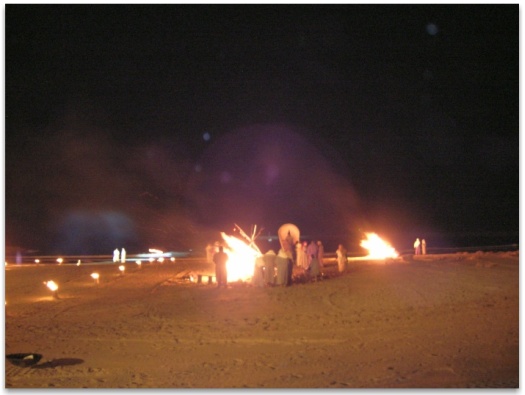
Orbs visible behind bonfires and smoke at the evocation of Les Saintes Maries de la Mer – large purple orbs in the foreground

Orbs visible behind bonfires and smoke at the evocation of Les Saintes Maries de la Mer – large purple orbs in the foreground
One scene in particular I could see thin white light in stripes streaming down from the unseen starship above and took a photo.
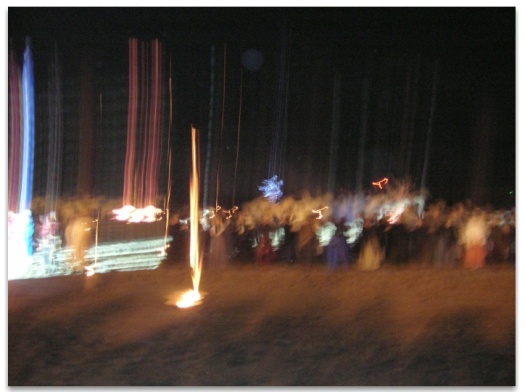
Lines of light descending at the evocation of Les Saintes Maries de la Mer
The evocation, as a sacred event, re-enacts the Holy and thus is a suspension of time and space. The energy at the Evocation is the sum of the sacred energy and devotion to the Two (Three) Marys and the flight to Gaul with their companions by the Gypsies over two millennia. The tradition of the evocation round Jesus and his companions call back that energy which surrounded his followers and the Marys, and the lines of light indicate Divinity is present pouring down divine sacred energy into the actors, the participants, and all the observers at the Evocation.
When all of the survivors gathered in a row, looking towards the crowd there were nine … not three as I had imagined in my mind; so I thought, “How could this be?” (Remember, we could not understand what was being said in the local French dialect).

The Nine members of the small boat – surrounded by bonfires, facing the cross at the evocation of Les Saintes Maries de la Mer
So I later asked Alcheringa, and his answer was:
“Over two thousand years ago, there were more than one boat that landed, I can assure you. The Gypsies welcomed the family and they, on the boats, knew all the people that were there waiting for them to land.
“Brother James, John the Divine, and Joseph of Arimathea were with them …
They moved on to other places … Mother Mary, her two daughters* were also with them … and of course Mary Magdalene who stayed in the area … moving from the shore to the mountains and spreading the teachings as she went. The teachings were not a religion, they were teachings from the Source, the Source of Creation. They were merely passing on a ‘way of life’; a ‘way to live.’ For at the time there were sacrifices and slavery going on and this is what they wanted to stop and to encourage people to love one another, to love the animals, to love all that was upon the earth and to appreciate and love Mother Earth—these are the teachings that were passed on. Jesus said, “Love one another as I have loved you.” ( Sai Baba says a similar thing in that God is Love, and that you are God.)
“The disciples of Jesus, as they were known, were simple people loyal and God loving … they had a special energy around them … they had all been enchristed … and people recognized that … so that when they spoke and put their hands out to communicate with people—people recognized that energy of Holy Spirit that went with them.“
I have been given insight to more about Jesus’ family. It unfolded as we traveled giving us an Ancient History lesson as we moved from place to place; of what happened to the disciples after Jesus was crucified; a later development of the Christian Church linked with Egypt; our own Soul History and even earlier major earth changes that had taken place around the Mediterranean sea pre. 12,000 years ago, and 60,000,000 yrs ago. John, my husband is not normally as open to these things, but on this trip he was well and truly receiving messages from his Mentor also.
I will be sharing many more stories in a number of articles about our journey on this website one by one.
With love,
Valerie
* Refer to Rosemary/Ruth’s regression to her lifetime as a half sister of Issa-Jesus and Jehanne/Judith’s regression to her lifetime as a half sister of Issa – Jesus.

The illuminated Camargue Cross of Les Saintes Maries de la Mer is carried into the evocation